
Animation is a filmmaking technique by which still images are manipulated to create moving images. In traditional animation, images are drawn or painted by hand on transparent celluloid sheets (cels) to be photographed and exhibited on film. Animation has been recognized as an artistic medium, specifically within the entertainment industry. Many animations are computer animations made with computer-generated imagery (CGI). Stop motion animation, in particular claymation, has continued to exist alongside these other forms.

It's a Wonderful Life is a 1946 American Christmas supernatural drama film produced and directed by Frank Capra. It is based on the short story and booklet "The Greatest Gift" self-published by Philip Van Doren Stern in 1943, which itself is loosely based on the 1843 Charles Dickens novella A Christmas Carol. The film stars James Stewart as George Bailey, a man who has given up his personal dreams in order to help others in his community and whose thoughts of suicide on Christmas Eve bring about the intervention of his guardian angel, Clarence Odbody. Clarence shows George all the lives he touched and what the world would be like if he had not existed.

A movie theater, cinema, or cinema hall, also known as a movie house, picture house, picture theater or simply theater, is a business that contains auditoria for viewing films for public entertainment. Most are commercial operations catering to the general public, who attend by purchasing tickets.
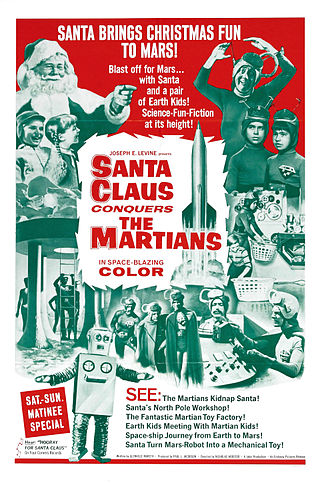
Santa Claus Conquers the Martians is a 1964 American science fiction comedy film. It was directed by Nicholas Webster, produced and written by Paul L. Jacobson, and based on a story by Glenville Mareth. John Call stars as Santa Claus, ten-year-old Pia Zadora as Girmar the Martian girl, and Doris Rich in the first documented motion picture role of Mrs. Claus.
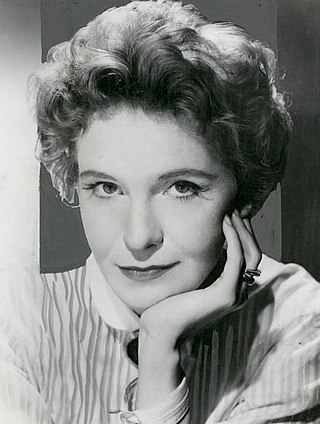
Geraldine Sue Page was an American actress. With a career which spanned four decades across film, stage, and television, Page was the recipient of numerous accolades, including an Academy Award, a British Academy Film Award, two Primetime Emmy Awards, two Golden Globe Awards, and four nominations for the Tony Award.

Popcorn is a variety of corn kernel which expands and puffs up when heated; the same names also refer to the foodstuff produced by the expansion.

Plaster is a building material used for the protective or decorative coating of walls and ceilings and for moulding and casting decorative elements. In English, "plaster" usually means a material used for the interiors of buildings, while "render" commonly refers to external applications. The term stucco refers to plasterwork that is worked in some way to produce relief decoration, rather than flat surfaces.
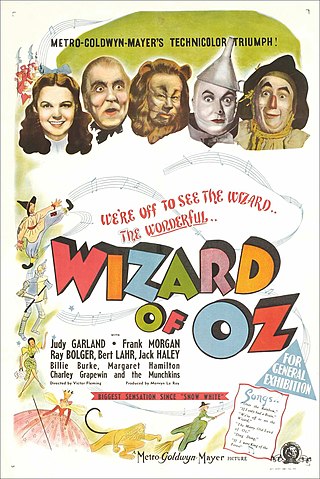
The Wizard of Oz is a 1939 American musical fantasy film produced by Metro-Goldwyn-Mayer (MGM). An adaptation of L. Frank Baum's 1900 children's fantasy novel The Wonderful Wizard of Oz, it was primarily directed by Victor Fleming, who left production to take over the troubled Gone with the Wind. It stars Judy Garland, Frank Morgan, Ray Bolger, Bert Lahr, Jack Haley, Billie Burke and Margaret Hamilton. Noel Langley, Florence Ryerson and Edgar Allan Woolf received credit for the screenplay, while others made uncredited contributions. The music was composed by Harold Arlen and adapted by Herbert Stothart, with lyrics by Edgar "Yip" Harburg.

USG Corporation, also known as United States Gypsum Corporation, is an American company which manufactures construction materials, most notably drywall and joint compound. The company is the largest distributor of wallboard in the United States and the largest manufacturer of gypsum products in North America. It is also a major consumer of synthetic gypsum, a byproduct of flue-gas desulfurization. Its corporate offices are located at 550 West Adams Street in Chicago, Illinois.

A grindhouse or action house is an American term for a theatre that mainly shows low-budget horror, splatter, and exploitation films for adults. According to historian David Church, this theater type was named after the "grind policy", a film-programming strategy dating back to the early 1920s which continuously showed films at cut-rate ticket prices that typically rose over the course of each day. This exhibition practice was markedly different from the era's more common practice of fewer shows per day and graduated pricing for different seating sections in large urban theatres, which were typically studio-owned.
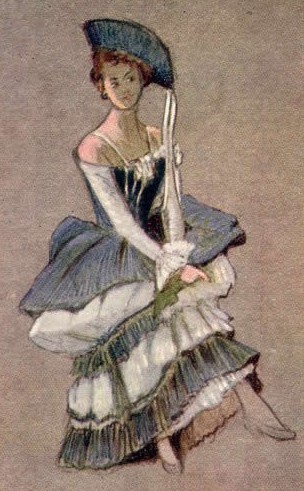
Costume design is the creation of clothing for the overall appearance of a character or performer. Costume may refer to the style of dress particular to a nation, a class, or a period. In many cases, it may contribute to the fullness of the artistic, visual world which is unique to a particular theatrical or cinematic production. The most basic designs are produced to denote status, provide protection or modesty, or provide visual interest to a character. Costumes may be for a theater, cinema, musical performance, cosplay, parties, or other events. Costume design should not be confused with costume coordination which merely involves altering existing clothing, although both create stage clothes.

A Christmas decoration is any of several types of ornamentation used at Christmastide and the greater holiday season. The traditional colors of Christmas are pine green (evergreen), snow white, and heart red. Gold and silver are also prevalent, as are other metallic colours. Typical images on Christmas decorations include Baby Jesus, Mother Mary, angels, Father Christmas, Santa Claus, and the star of Bethlehem. Advent wreaths, nativity scenes, illuminations, and Moravian stars are popular Christmas decorations.
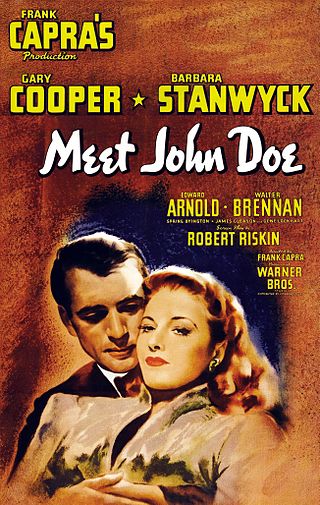
Meet John Doe is a 1941 American comedy drama film directed and produced by Frank Capra, written by Robert Riskin, and starring Gary Cooper, Barbara Stanwyck and Edward Arnold. The film is about a "grassroots" political campaign created unwittingly by a newspaper columnist with the involvement of a hired homeless man and pursued by the paper's wealthy owner. It became a box-office hit and was nominated for an Academy Award for Best Story. It was ranked No. 49 in AFI's 100 Years ... 100 Cheers. In 1969, the film entered the public domain in the United States because the claimants did not renew its copyright registration in the 28th year after publication. It was the first of two features Capra made for Warner Brothers, after he left Columbia Pictures, the other being Arsenic and Old Lace (1944).
Structural film was an avant-garde experimental film movement prominent in the United States in the 1960s. A related movement developed in the United Kingdom in the 1970s.
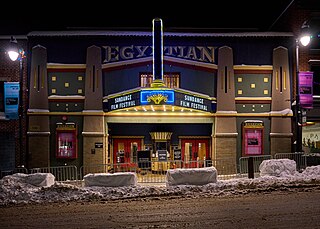
The Egyptian Theatre is located at 328 Main Street in Park City, Utah in the United States. It has also been referred to as the Mary J. Steiner Egyptian Theatre or Egyptian Theatre in Park City and is built in the style of Egyptian-themed theatres from the 1920s that followed the discovery of the tomb of Tutankhamun.

Theatrical blood, stage blood or fake blood is anything used as a substitute for blood in a theatrical or cinematic performance. For example, in the special effects industry, when a director needs to simulate an actor being shot or cut, a wide variety of chemicals and natural products can be used. The most common is red food coloring, often inside small balloons coupled with explosive devices called squibs.

Asbestos is a naturally occurring fibrous silicate mineral. There are six types, all of which are composed of long and thin fibrous crystals, each fibre being composed of many microscopic "fibrils" that can be released into the atmosphere by abrasion and other processes. Inhalation of asbestos fibres can lead to various dangerous lung conditions, including mesothelioma, asbestosis, and lung cancer. As a result of these health effects, asbestos is considered a serious health and safety hazard.

A snowflake is a single ice crystal that has achieved a sufficient size, and may have amalgamated with others, which falls through the Earth's atmosphere as snow. Each flake nucleates around a tiny particle in supersaturated air masses by attracting supercooled cloud water droplets, which freeze and accrete in crystal form. Complex shapes emerge as the flake moves through differing temperature and humidity zones in the atmosphere, such that individual snowflakes differ in detail from one another, but may be categorized in eight broad classifications and at least 80 individual variants. The main constituent shapes for ice crystals, from which combinations may occur, are needle, column, plate, and rime. Snow appears white in color despite being made of clear ice. This is due to diffuse reflection of the whole spectrum of light by the small crystal facets of the snowflakes.
Russell Morrison Shearman was an Oscar-winning American special effects artist. He was electrocuted while repairing equipment used in filming The Sharkfighters in Cuba 1956, serving as head technician on the picture.





















